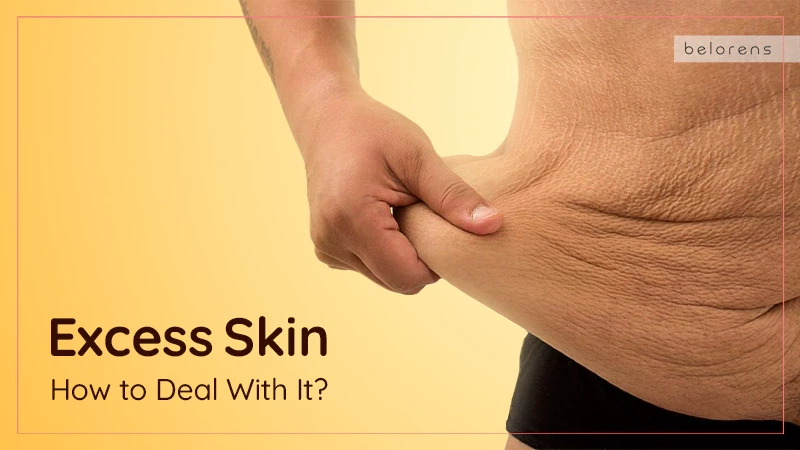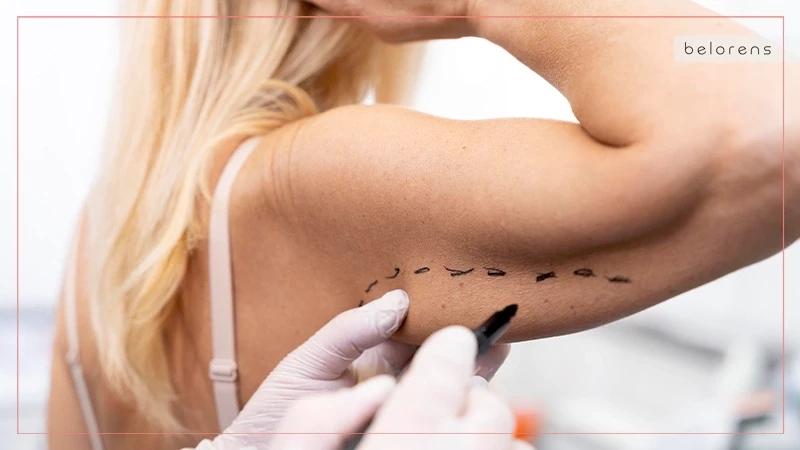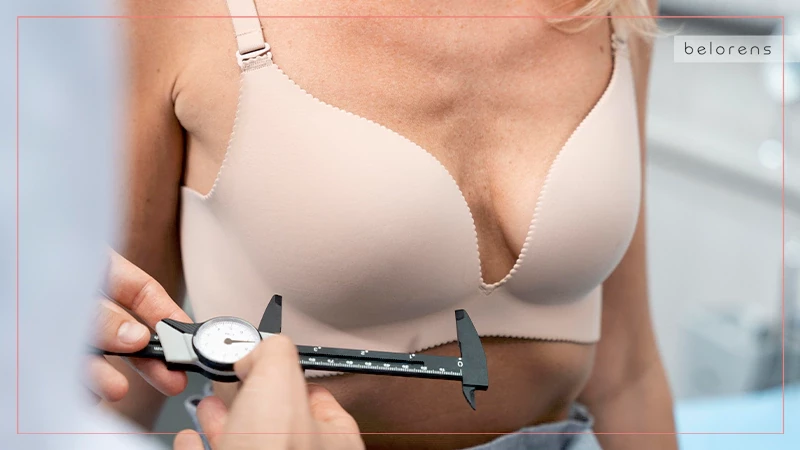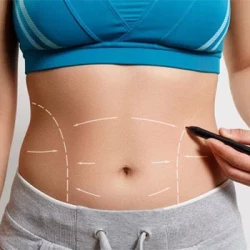Excess Skin: How to Deal With It After Surgery or Weight Loss?
- ByMedical Content Team
- Medically Reviewed byDr. Sabine Kulhanek
Fact checked

Excess skin is one of the major struggles of formerly obese individuals. While the process of weight loss is a massive achievement, it is sadly not the end of the road to self-improvement. Once the fat underneath the skin is gone, the stretched skin remains in an excess form that causes physical and emotional issues. There are also various health implications involved. So, in this article, we will tackle all of these topics, as well as how to deal with excess skin in surgical and non-surgical ways.
How do we get Excess Skin?
Contrary to popular belief, excess skin is not caused just by being obese. There are multiple factors at play, and it is important to understand all of them in order to avoid preconceived notions, as well as to understand the topic at hand better. Here are all the reasons that lead to excess skin in an individual.
Advancing Age
The natural aging process diminishes skin elasticity as collagen and elastin, proteins providing structure and flexibility, decrease. This makes the skin less adept at adjusting to changes in body shape.

Genetic Influence
Genetic factors play a role in determining skin elasticity, influencing how the skin responds to weight loss. Genetic predispositions may contribute to varying levels of skin elasticity among individuals.
Long-Term Obesity
Prolonged periods of being overweight or obese increase the likelihood of loose skin after substantial weight loss. Continuous stretching of the skin due to excess weight can compromise its ability to regain firmness.
Multiple Pregnancies
Women who undergo multiple pregnancies may be prone to excess abdominal skin, particularly if the skin has stretched during each pregnancy. This condition is often colloquially referred to as a "mommy belly."

Collagen and Elastin Levels
Essential proteins like collagen and elastin maintain skin elasticity. Factors such as smoking, prolonged sun exposure, and inadequate nutrition can reduce collagen and elastin levels, making the skin more susceptible to sagging.
Everyday Problems Caused by Excess Skin
While not known to the outside world, an individual suffering from excess skin can face some serious issues in their daily lives. These issues can be categorized into two distinctive groups: emotional and physical. Reading about this helps us to better understand the challenges of people with loose skin, as well as to prepare ourselves to prevent it. As the old saying goes, prevention is better than cure!
Physical Issues
Here are all the potential physical issues a person with excess skin may suffer from.
- Hygiene Challenges: Excess skin folds pose challenges to maintaining proper hygiene, with moisture and friction in these folds possibly causing irritation and elevating the risk of skin infections.
- Discomfort and Chafing: Constant rubbing of excess skin against clothing or other skin surfaces can result in discomfort and chafing, leading to redness, soreness, and, in severe cases, open sores.
- Limited Clothing Options: Individuals dealing with excess skin may encounter difficulty finding well-fitting and comfortable clothing. The availability of styles accommodating or concealing excess skin can be restricted, impacting personal style choices.

- Physical Activity Restrictions: Excess skin may impede engagement in physical activities, limiting the ability to exercise comfortably. This limitation can affect overall fitness levels and the enjoyment of an active lifestyle.
- Difficulty in Maintaining Weight Loss: Some individuals may find it tough to sustain their weight loss achievements due to the physical discomfort linked to excess skin. This challenge can result in emotional distress, hindering long-term weight management.
- Skin Irritation and Infections: Excess skin folds create an environment conducive to fungal or bacterial infections by trapping moisture. Conditions like intertrigo may develop, causing redness, itching, and discomfort.
- Sleep Disturbances: Excess skin can disrupt sleep comfort, making it challenging to find a comfortable sleeping position. This disturbance can lead to disrupted sleep patterns and potential fatigue.
Emotional Issues
Experiencing loose skin often brings forth a variety of emotional challenges as well. Here are some examples.
- Self-Esteem and Confidence Issues: The existence of excess skin may result in diminished self-esteem and confidence, causing discomfort in social situations and a heightened fear of judgment or scrutiny from others.
- Fear of Rejection: Apprehensions about being judged or rejected by others based on the presence of excess skin can contribute to social anxiety. This fear might influence relationships and impede the development of new connections.
- Depression and Anxiety: Emotional distress linked to excess skin can give rise to symptoms of depression and anxiety. The persistent concern about one's appearance and the perceived limitations it imposes can be emotionally burdensome.

- Regret or Disappointment: Individuals who have dedicated considerable effort to achieving weight loss goals may experience a sense of regret or disappointment when confronted with excess skin. This emotional reaction could overshadow the pride and accomplishment of the weight loss journey.
- Avoidance of Social Activities: Encountering excess skin may generate a desire to steer clear of social activities and public spaces. The fear of judgment or discomfort in social situations may lead to withdrawal from social life.
- Impact on Intimacy: Emotional challenges linked to excess skin can extend to intimate relationships. Individuals might feel hesitant or insecure about unveiling their bodies to partners, potentially impacting intimacy and communication.
- Struggle with Identity: The physical transformation resulting from weight loss and the presence of excess skin could give rise to a struggle with identity. Individuals may grapple with reconciling their current appearance with their past and present sense of self.
Surgical Solutions for Excess Skin
Surgical solutions for excess skin are often sought by individuals who have undergone significant weight loss or experienced changes in body composition due to factors such as pregnancy or aging. These procedures, collectively known as body contouring or skin removal surgeries, aim to address the loose skin and restore a more contoured and proportionate appearance. Here, we delve into the details of surgical excess skin solutions, exploring common procedures, their processes, and considerations.
Also Read: 7 Myths about Weight Loss Surgeries
Abdominoplasty (Tummy Tuck)
Abdominoplasty, also known as tummy tuck is a widely performed surgical procedure designed to address loose skin and fat in the abdominal area.

The surgeon removes excess skin and tightens the underlying muscles, resulting in a flatter and more toned abdomen. This procedure is particularly popular among individuals who have undergone substantial weight loss or pregnancy.
Also Read: How Are Liposuction and Tummy Tuck Different?
Brachioplasty (Arm Lift)
Brachioplasty or arm lift focuses on excess skin in the upper arms, commonly referred to as "bat wings."

The surgeon removes loose skin and fat, reshaping the arms for a more defined and youthful appearance. This procedure is often sought by individuals with sagging arm skin due to weight loss or aging.
Thigh Lift
Thigh lift surgery targets excess skin on the thighs, addressing issues such as sagging or loose skin.

The surgeon removes loose skin and may perform liposuction to enhance contouring. Thigh lift surgery can improve the overall appearance of the thighs and buttocks.
Breast Lift (Mastopexy)
Breast lift surgery is commonly chosen by individuals experiencing sagging or drooping breasts due to factors like weight loss, pregnancy, or aging.

The surgeon lifts and reshapes the breasts by removing excess skin, repositioning the nipple-areola complex, and enhancing breast firmness.
Lower Body Lift
A lower body lift is a comprehensive procedure addressing excess skin around the lower torso. It typically includes a combination of abdominoplasty, thigh lift, and buttock lift to achieve a more harmonious and proportionate lower body contour.
Opting for surgery can be a difficult decision to make; we have linked you to our services regarding these surgeries, but to give you an extra boost of confidence, you can see the first-hand results in the form of before and after photos for yourself!
The Surgical Process
The journey begins with a thorough consultation with a board-certified plastic surgeon. The surgeon assesses the patient's medical history, discusses aesthetic goals, and evaluates the extent of excess skin to determine the most suitable surgical approach.
Also Read: Do I Need Weight Loss Surgery? Which One Is the Best For Me?
Before surgery, patients undergo preoperative assessments, which may include medical tests and evaluations to ensure they are in good health for the procedure. The surgeon provides preoperative instructions, which may include lifestyle adjustments, medication management, and cessation of smoking if applicable. The surgical procedure varies based on the targeted area. In general, the surgeon makes incisions strategically placed to minimize visible scarring. Excess skin is carefully excised, and underlying tissues are tightened and reshaped. If necessary, liposuction may be performed to enhance contouring.
Postoperative recovery involves a period of rest, with patients typically advised to avoid strenuous activities. The surgeon provides guidelines for wound care, pain management, and follow-up appointments to monitor healing progress.
Over the following weeks and months, patients witness the gradual transformation of their bodies as swelling subsides and scars fade. The final results become more apparent, revealing a more sculpted and proportionate physique.
Considerations and Risks
While surgical excess skin solutions can yield transformative results, individuals considering these procedures should be aware of potential risks and considerations. Here are some of them.
Surgical procedures result in scars, and the extent varies depending on factors such as incision length and healing patterns. Surgeons aim to place incisions strategically to minimize visible scarring.
Also Read: How to Minimize Tummy Tuck Scars?
Recovery times vary among procedures, with patients generally advised to take time off work and avoid strenuous activities during the initial stages of healing. Full recovery may take several weeks to months.

As with any surgical procedure, there are potential risks, including infection, bleeding, and adverse reactions to anesthesia. Following preoperative and postoperative guidelines helps mitigate these risks. Maintaining a healthy lifestyle, including a balanced diet and regular exercise, is crucial for optimizing and sustaining the results of surgical excess skin solutions.
Non-Surgical Solutions for Excess Skin
Non-surgical solutions for excess skin provide alternative avenues for individuals seeking to address the challenges associated with loose or sagging skin, particularly after significant weight loss or changes in body composition. These non-invasive approaches focus on skin tightening, toning, and overall rejuvenation without the need for surgical intervention. Here, we explore various non-surgical solutions, their mechanisms, and considerations for individuals contemplating these alternatives.
Topical Creams and Lotions
Topical products enriched with ingredients like retinoids, collagen, and hyaluronic acid aim to improve skin elasticity and hydration. While these creams may not provide drastic results, consistent use can contribute to a modest reduction in the appearance of fine lines and mild skin laxity.
Radiofrequency (RF) Therapy
RF therapy employs radiofrequency energy to stimulate collagen production and enhance skin tightness.

This non-surgical option is often used to address mild to moderate skin laxity on the face, neck, and body. The heat generated during the treatment promotes collagen remodeling, leading to gradual improvements in skin tone and firmness.
Ultrasound Therapy
Ultrasound therapy, commonly known as Ultherapy, utilizes focused ultrasound energy to penetrate the deeper layers of the skin. This stimulates collagen production and tightens loose skin. Ultherapy is FDA-approved for use on the face, neck, and décolletage, providing a non-invasive alternative to surgical facelifts.
Laser Therapy
Laser treatments, such as fractional laser, laser resurfacing, and non-ablative laser procedures, target specific areas of the skin to promote collagen synthesis.

These therapies can improve skin texture, reduce fine lines, and contribute to mild skin tightening. They are often used on the face, but some technologies are suitable for other body areas.
Microneedling
Microneedling involves the use of fine needles to create controlled micro-injuries in the skin. This stimulates the natural healing process, promoting collagen and elastin production. Microneedling can enhance skin texture, reduce the appearance of scars, and contribute to mild skin tightening.
Dermal Fillers
Dermal fillers, such as hyaluronic acid injections, are commonly used to address volume loss in the face. While not a direct solution for excess skin, strategically placed fillers can improve overall facial contours and reduce the appearance of sagging in certain areas.
Body Contouring Devices
Non-surgical body contouring devices, such as cryolipolysis (CoolSculpting) and radiofrequency devices, target specific areas of the body to reduce localized fat deposits and improve skin tone. While primarily designed for fat reduction, these treatments may offer some degree of skin tightening as a secondary benefit.
Also Read: Understanding the Distinction between CoolSculpting and Liposuction
Lifestyle Changes
Adopting a healthy lifestyle can significantly impact skin health. Regular exercise, a balanced diet rich in nutrients, and proper hydration contribute to overall skin vitality. Maintaining a stable and healthy weight can also prevent further skin laxity.
Considerations for Non-Surgical Solutions:
Treatment Duration and Consistency
Non-surgical solutions often require multiple sessions for optimal results. Individuals should be prepared for a gradual improvement process and commit to the recommended treatment schedule.
While non-surgical options can provide noticeable improvements, they may not achieve the same level of transformation as surgical procedures. Realistic expectations are crucial to satisfaction with the results.
Non-surgical treatments typically involve minimal to no downtime, allowing individuals to resume normal activities immediately or shortly after the procedure. This can be an attractive aspect for those seeking convenience and minimal disruption to daily life.
The cost of non-surgical treatments varies, and multiple sessions may be needed for optimal results. While generally more affordable than surgery, individuals should consider the cumulative cost and weigh it against their budget.
Conclusion
In conclusion, most people who suffer from excess skin are already people who have struggled with difficult processes such as multiple pregnancies, prolonged obesity, etc. Excess skin poses an additional challenge for them, but through the utilization of surgical and non-surgical methods, everyone can get rid of their loose skin and return to a happy life.
FAQ
Can excess skin be prevented?
While it's challenging to entirely prevent excess skin, maintaining a gradual and steady rate of weight loss, staying hydrated, and incorporating strength training exercises may help minimize its occurrence.
Do non-surgical solutions really work for excess skin?
Non-surgical solutions, such as radiofrequency therapy, ultrasound therapy, and laser treatments, can provide noticeable improvements in skin tone and texture. However, the extent of improvement varies among individuals, and realistic expectations are
How long does it take to see results from non-surgical treatments?
Results from non-surgical treatments are often gradual and may require multiple sessions. Visible improvements can start to emerge in the weeks following the initial treatment, with continued enhancements over several months.
What are the risks associated with non-surgical solutions?
Non-surgical treatments generally have minimal risks, such as temporary redness or swelling. Serious complications are rare, but it's crucial to follow post-treatment guidelines and choose a qualified professional for the procedure.
Are non-surgical treatments painful?
Discomfort levels vary depending on the treatment. Some procedures may cause mild discomfort, which is usually well-tolerated. Topical anesthetics or cooling devices are often used to enhance comfort during the procedure.
Can excess skin be toned through exercise alone?
While exercise can improve muscle tone, it may not directly address excess skin. Strength training can contribute to overall body contouring, but in many cases, a combination of exercise and other interventions may be more effective.
How do I choose between surgical and non-surgical solutions?
The choice between surgical and non-surgical solutions depends on factors such as the severity of excess skin, individual goals, budget, and tolerance for downtime. Consulting with a healthcare professional will help determine the most suitable option.
Is excess skin removal covered by insurance?
In most cases, excess skin removal is considered a cosmetic procedure and is not covered by insuwerance. However, if excess skin causes medical issues like skin infections, insurance may cover a portion of the surgical interventio.





